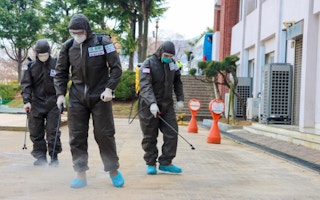The Covid-19 virus shows all indications of disrupting every individual’s life habits. While social isolation has largely been voluntary so far, fear of the disease is coercing some to ostracise others who may show related symptoms. The helplessness factor has also initiated a blame-game of sorts, with a few even allocating this coronavirus a nationality.
To continue reading, subscribe to Eco‑Business.
There's something for everyone. We offer a range of subscription plans.
- Access our stories and receive our Insights Weekly newsletter with the free EB Member plan.
- Unlock unlimited access to our content and archive with EB Circle.
- Publish your content with EB Premium.
Some people are seen to discover religion anew, while others have displayed acts of kindness, reported from around the world. Sadly, that means that pain abounds, and it is most unfortunate doctors have had to resort to triaging patients due to high loads on the medical system in a few regions.
This pandemic has left everyone focusing on one hope—to ‘dampen the curve’ and buy time, so local healthcare networks can cope with the numbers expected. We appear to have no other recourse against this invisible enemy, but to consciously isolate from unnecessary proximity until a vaccine is developed.
Social distancing and self-Isolation is the first tool in our armoury, to delay the spread of Covid-19. A vaccine is the next move, but are we prepared to make use of it properly?
The Covid-19 vaccine will be delivered either this year, if testing is fast-tracked, or next year. Depending on how the disease spreads in the coming months, a conscious decision might be taken to waive some standard trials and safety procedures. It will be a tough risk assessment call.
However, there is one risk that cannot be taken. There is no scope to bypass the logistics that will ensure the vaccine can reach every infected region of the world as a priority, and then other pockets that might have escaped. Unless the virus dies out on its own, which appears unlikely, a vaccine will be the only safeguard for billions.
Nations must ready themselves for the vaccine and plan an extensive delivery mechanism. The worrisome part is that, even today, the existing vaccination system for well-mapped viruses does not necessarily reach every person in need. This state of affairs needs to be reassessed to ensure the coronavirus vaccine will reach all. While today we worry about hospital equipment and beds as we dampen the infection, shortly we will have to ensure the vaccine is available in every remote hamlet and village around the world.
We can hope that the vaccine will be a once-only shot rather than a seasonal requirement. No matter what, it will need to reach every corner of the world. We cannot afford to ignore that the next trouble spot will be executing a globally networked delivery mechanism for the Covid-19 vaccine. It may be the only way to stop this virus in its tracks, and get civilisation back on its feet.
Vaccines need to be handled within specified temperature ranges. In all probability, the protocols to follow will be like those for the Influenza vaccine, which must be kept between 2°C and 8°C, while in transport and storage. The problem to consider is whether we can inoculate all eight billion people on the planet? Will the current cold-chain network be capable of handling extraordinarily large quantities of the vaccine? Clearly, the current system is designed to cope with the existing scale of vaccination, in each country.
The scale of Covid-19 vaccine outreach will be in multiples of present status, and countries must plan accordingly. It is not a matter of adding capacity of vaccine refrigerators at existing vaccination centres, but possibly creating a different structure. Each pharmaceutical outlet could be enabled to store and inject the vaccine – perhaps even at outlets in shopping malls, universities, offices or theatres.
Doing so, will immediately multiply the delivery points of the vaccine, and avoid crowding existing hospitals and clinics. A few million individuals can be quickly trained to inoculate and each inoculation will have to be recorded with an extensive database collated. The unique identity of each citizen will come handy here, to be mapped against the vaccination, not a single person can be bypassed. This will require a mobilisation, even exceeding the scale that India executes for its elections.
Existing cold-chain enterprises may need to allocate specific resources in their network with a minor redesign to designate storage space and transport load for the vaccine. The food cold-chain has the maximum reach, with an extensive last mile connectivity. Most importantly, private operators will have to safely process vaccine loads. Non-standardised care will be disastrous and training will be needed. If we do it well, cooling will have touched the lives of all.
Responsibility for the Covid-19 vaccination program will fall in the lap of governments, with each ensuring that all its citizens are inoculated. This cannot be left entirely to private enterprise. Public funds must be allocated and this public service will have to be well planned. Government offices that deal in cold-chain and healthcare services will need to converge and partner more than they ever have before. Some forethought will be needed to execute this well, in a timely and speedy manner.
Most cold-chains do not handle medical supplies. Such cold-chain operators must familiarise themselves with related protocols and be ready to roll into action. If they need additional equipment or monitoring tools, they must prepare a list in advance and inform local health services. Health authorities must develop an appropriate platform to keep record of each vaccination. In the long run, a permanent network of infrastructure and people may be needed. New infrastructure must only deploy sustainable cooling technologies so we do not compound the problem of unwanted carbon emissions. We have the time to be ambitious and must plan for resilient and sustainable solutions.
We don’t yet know how bad this coronavirus is for humankind, but the fact that countries are willingly locking down is ample indication even a fool could not miss. Let us not be satisfied merely with slowing its murderous spread. Before we can build enough hospitals to handle projected numbers, we will have a vaccine. That is the next tool in our arsenal – and we must prepare to use it properly and effectively.
We can wish for the rapid development of the Covid-19 vaccine and hope it immunises people against this virus for life. Most importantly, we must plan an efficient delivery mechanism to ensure that the vaccine will be provided to everyone on the planet.
Pawanexh Kohli is honorary professor of post-harvest Logistics at the University of Birmingham











